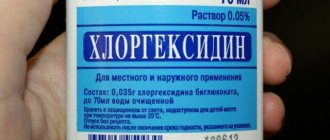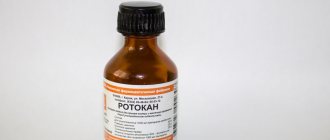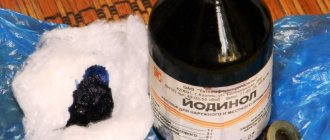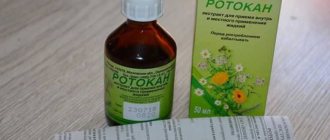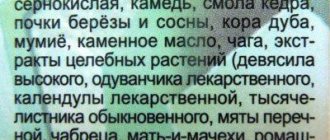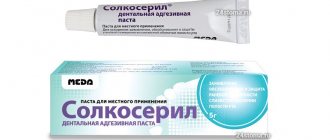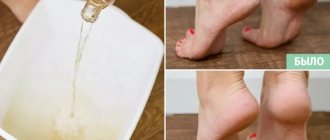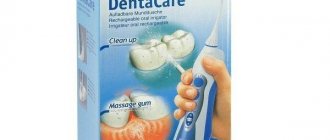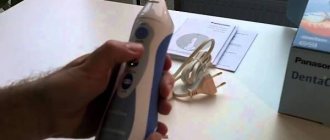Tooth extraction is a complex and traumatic dental operation, after which the patient must follow certain recommendations to prevent postoperative inflammatory processes and complications. It is very important to maintain oral hygiene to prevent the proliferation of bacterial flora and infection of the soft and hard tissues of the teeth. For this purpose, the patient is prescribed a combination of therapeutic and prophylactic therapy using antibacterial and antimicrobial drugs (for example, Metronidazole) and disinfectant solutions for local treatment.
Removal of a tooth
One of the safest, most effective and affordable disinfectants is Chlorhexidine. This is a combined agent that destroys representatives of fungal, microbial and bacterial flora, providing sanitation of teeth and mucous membranes after surgical procedures to extract a tooth from the bone alveolus. It can be used by patients of any age. If necessary, Chlorhexidine can be used to prevent complications after extraction in children and pregnant women.
Rinse after tooth extraction with Chlorhexidine
What is Chlorhexidine?
"Chlorhexidine" is a clear liquid with a characteristic odor of ethyl alcohol, which has antimicrobial and antibacterial effects. The drug is used for antiseptic treatment of the skin and mucous membranes after surgical operations, for accidental injuries and injuries accompanied by a violation of the integrity of the skin: scratches, cuts, abrasions. The product can be used to disinfect hands if it is not possible to provide standard hygienic treatment with water and soap.
The mechanism of action of the drug on the bacterial cell
The active ingredient of the antiseptic is chlorhexidine in the form of bigluconate. The drug is available in several dosage forms for local and external treatment:
- spray;
- solution;
- vaginal suppositories (suppositories).
In dentistry, Chlorhexidine is used in the form of a spray and solution. It is used to treat hands, medical instruments, and is also used to disinfect the oral cavity after dental treatment using surgical methods. The effect of the drug lasts up to four hours after use.
"Chlorhexidine"
The active substance is active against most pathogenic microorganisms, which include gram-negative and gram-positive bacteria, various groups of viruses, yeast-like fungi, and dermatophytes. Chlorhexidine is especially effective for the prevention of dental infections caused by chlamydia and trichomonas.
"Chlorhexidine" after tooth extraction
Chlorhexidine for oral diseases
The drug solution is often prescribed for certain dental diseases:
- stomatitis;
- gingivitis and periodontitis.
Stomatitis
For the aphthous form of the disease, rinsing with a chlorhexidine solution is effective. The product also helps with candidiasis of the oral cavity. Treatment usually does not take longer than 10 days.
Gingivitis and periodontitis
Diseases caused by the formation of accumulation of bacteria in subgingival pockets lead to bleeding gums and tooth mobility. In such a situation, rinsing alone is not sufficiently effective. Chlorhexidine is used comprehensively for the treatment of these diseases:
- treat the surface with the solution during cleaning;
- an antiseptic-based drug is placed in the pockets on the gums;
- rinsing with a chlorhexidine-based solution.
Two-week treatment allows you to relieve the main symptoms and reduce the concentration of microbes in the oral cavity several times. Chlorhexidine is also used as a prophylactic against gingivitis and periodontitis. This is especially true after oral surgery or when it is impossible to maintain proper hygiene. Removable prosthetic structures can be soaked in the drug solution to disinfect and prevent gum inflammation.
Chlorhexidine solution is the most effective antiseptic for the oral cavity; it has a unique property - when rinsing, a thin protective film is formed on the mucous membrane, which continues to act for several more hours after rinsing.
Why do you need Chlorhexidine: properties and action
After a tooth is removed, an open wound remains in the gum and fills with blood. A blood clot forms in the hole, protecting the open area of the periosteum from the penetration of pathogenic bacteria and microbes. If the clot does not adhere tightly to the socket or is accidentally damaged during eating, the risk of infection of the bone tissue and the development of osteomyelitis of the jaw increases - a purulent-inflammatory pathology, which, if not treated in a timely manner, can lead to the death of bone structures (osteonecrosis).
And this is how a blood clot may look in real life - it is very important not to wash it out when rinsing your mouth
To avoid damaging the clot, the following recommendations must be followed:
- in the first 1-2 days after removal, you should not drink through a straw, spit saliva, or perform other actions that create a vacuum in the mouth;
- You can chew on the side on which the removal took place 72 hours after surgery;
- You need to rinse your mouth carefully, trying not to make too active movements;
- Do not touch the clot with your tongue or try to remove it from the hole.
Another common complication after tooth extraction is alveolitis. This is a disease in which inflammation of the socket occurs. The pathology is accompanied by fever, severe pain, which can radiate to the ear, eye area, jaw and cervical and submandibular lymph nodes. The gums at the extraction site swell, and severe swelling and redness appear.
- How to rinse your mouth with Chlorhexidine for gum inflammation
Development of alveolitis in the socket after tooth extraction
The main cause of alveolitis is non-compliance with the hygiene regime and an increase in the number of pathogenic flora in the oral cavity. Pathogenic microorganisms entering the alveoli cause inflammation of soft tissues and the development of a pathological process. To prevent alveolitis and other possible complications, the patient is prescribed local treatment of the oral cavity with antiseptic solutions, one of which is Chlorhexidine. The use of this drug ensures disinfection of the mucous membranes and hard tissues of the tooth and prevents the development of infectious and inflammatory processes.
Tooth extraction is a full-fledged surgical operation.
Video - “Chlorhexidine”: application and effectiveness
What solution to use for rinsing the mouth after implantation
It is recommended to use an aqueous 0.05% solution. It is effective even with large blood clots after extraction and promotes rapid wound healing. Rinses are prescribed in courses as prescribed by the dentist. You cannot use the drug for longer than the recommended period due to the risk of severe irritation of the mucous membrane.
Smokers and people with diabetes can use alcohol-based Chlorhexidine rinses. This composition ensures high safety and stabilization of the drug. Local treatment with an alcohol-containing drug significantly reduces the formation of plaque in the oral cavity, especially after implantation.
How to rinse your mouth?
To rinse the mouth, only an aqueous solution is used - this point should be taken into account when purchasing the drug at the pharmacy. The concentration of the drug is 0.05%. Some, trying to achieve the maximum therapeutic effect, begin to rinse their mouth too often - up to 6-10 times a day. This approach is completely unjustified and can harm a person, since rinsing too often can cause irritation of the mucous membranes and dislodge the blood clot, which protects the exposed bone from the penetration of microbes.
"Chlorhexidine" in the form of a solution
To ensure therapeutic and prophylactic results, it is enough to perform the procedure 2 times a day after morning and evening brushing of teeth. If your gums are prone to bleeding, you can add one more rinse, but the total number of procedures per day should not exceed three.
Video: How to rinse your mouth with chlorhexidine
How to rinse your mouth correctly
Mouth rinsing with Chlorhexidine is carried out according to the following scheme:
- brush your teeth;
- after an hour, rinse your mouth and throat with boiled water at room temperature to remove dirt and food debris;
- take a small amount of the drug into your mouth and hold for 2-3 minutes;
- Carefully spit out the product, avoiding swallowing.
The duration of treatment is from 7 to 12 days.
You just need to keep the product in your mouth
Important! "Chlorhexidine" after tooth extraction can only be used for oral baths. The product must be kept in the mouth, it is allowed to tilt the head slightly to the sides, but you cannot move the cheeks and tongue, as this creates a vacuum in the mouth and can lead to the loss of a blood clot.
What needs to be done in parallel with rinsing -
But after tooth extraction, it is important to perform not only antiseptic rinses (baths) in the oral cavity, but also to follow other recommendations, which will fully allow you to avoid the development of inflammation in the socket of the extracted tooth. Also, in addition to following general recommendations, in some cases it may be necessary to take medications - analgesics, antihistamines, and antibiotics.
- Analgesics (NSAIDs group) – the optimal choice of painkillers in dentistry are drugs from the NSAIDs group (non-steroidal anti-inflammatory drugs). Drugs in this group not only relieve pain well, but also at the same time reduce inflammation in tissues. If the removal was difficult, it is best to start taking one of these drugs before the local anesthesia wears off. Drugs from the NSAID group include: ibuprofen, nurofen, ketorol, ketanov, ketoprofen and others (which one is better - read the link above).
- Antihistamines - this group of drugs has not only antiallergic, but also anti-edematous/anti-inflammatory effects, and also enhances the effect of analgesics. If the removal was very traumatic, then we recommend taking a drug such as Suprastin for the first 3 days (1 tablet 1 time per day before bedtime).
- Antibiotic therapy - antibiotics are prescribed by a doctor in two cases. Firstly, when a tooth was removed due to purulent inflammation (with or without a gum incision). This is very important because... infection can lead to suppuration of the blood clot, its necrotic disintegration and the development of alveolitis. Typically, dental surgeons prescribe the antibiotic Lincomycin (2 capsules 3 times a day, for 5-7 days). But for gastrointestinal diseases, it is better to use Flemoxin Solutab or Unidox Solutab.
Precautions and tips for use
During the procedure, you should avoid getting the product into the digestive tract - this can lead to irritation of the mucous membranes of the stomach and intestines and cause inflammation of the surface layer of the gastrointestinal tract. Also, you should not use the drug for longer than the permissible period. Too long use of products based on chlorhexidine digluconate can lead to the destruction of beneficial oral flora and the development of dysbacteriosis.
Antiseptic "Chlorhexidine"
Dysbacteriosis of the oral cavity is accompanied by an unpleasant odor from the mouth, a dense coating on the inner surface of the cheeks and tongue, and other symptoms. Pathology is the main cause of stomatitis - inflammation of the mucous membranes of the oral cavity, most often of an infectious nature.
- Rinse after tooth extraction to heal gums
Before rinsing, it is important to maintain an hour's interval with hygiene measures, since the active ingredient "Chlorhexidine" is incompatible with some types of chemicals that may be included in toothpastes, powders and rinses. These include:
- colloids;
- alkaline compounds;
- carboxymethylcellulose;
- soap;
- gum arabic, etc.
"Chlorhexidine" is one of the most effective and popular antiseptics
Note! After rinsing your mouth with Chlorhexidine, you should not eat or drink for 1-1.5 hours. Eating foods earlier will reduce the effectiveness of the procedure.
Visiting the dentist
Gum baths
Dentists say: in recent years, approaches to certain procedures have changed, in particular rinsing for diseases of the teeth and gums. What new do experts offer?
The story is told by Elena Vasilyevna Zoryan, Candidate of Medical Sciences, Associate Professor of the Department of General Dentistry and Anesthesiology of the Moscow State Medical and Dental University.
– Rinsing is a simple and familiar procedure. Could there really be any innovations in relation to it?
– Yes, no matter how surprising it sounds. Many of us take rinsing very lightly, in the traditional sense of the word, believing that the more often we do it, the better. This way you can clean the oral cavity and get rid of many harmful microorganisms that tend to settle there. This is of course true.
But the problem is much broader - the fact is that along with microbes we also wash away saliva. And it plays an important protective role and protects us from infection. In particular, it contains lysozyme, which itself has an antibacterial effect. As well as substances that inhibit the proliferation of various bacteria and other microorganisms. And by removing saliva, we lose all this protection.
In order not to be left alone with germs, you need to learn how to rinse your mouth correctly.
- How exactly?
– We usually do it this way: we put water in our mouth, rinse it, and then spit it out. This method is justified only in some situations, for example, when rinsing after eating. This allows you to clean your mouth and remove any remaining food. Or after brushing your teeth, when you need to wash off the toothpaste.
In cases where we use rinsing as a therapeutic procedure, we need to rinse differently. Take a solution containing the necessary medications into your mouth, hold it for a while on the side where there is inflammation or damage to the gum mucosa, and then spit it out. In medical parlance, this method of rinsing is called “oral baths.”
The temperature of the solution should be warm - about 40 degrees. Too hot water can cause an exacerbation of inflammation, and too cold water can narrow blood vessels and disrupt cell nutrition.
In one session, it is effective to do 5-7 rinses for 30-40 seconds. If the inflammation is in the acute stage, then it is advisable to rinse frequently. When the inflammation is relieved, 3-4 times a day is enough.
– There is another option for local treatment – applications. In what cases are they used and can they be a replacement for rinses?
– Applications are the application of a special ointment, gel and solution directly to the damaged area. They can be used either independently or in addition to rinses.
When treating small children, rinsing is not used. Due to their age, they cannot rinse their mouth; they simply take water and swallow it. Therefore, rinsing with medicinal solutions in the first years of life is not recommended; at best, irrigation is used. Applications are often a real way out of the situation. In this case, the doctor can select the dosage form - solution, gel, ointment - individually.
– Are there any other cases when rinsing is undesirable?
– If we are talking about rinsing with medications, then we need to look into each individual case. How does this drug work and for what purpose is it used in this case? Any drug can cause not only allergies, but also other side effects. Therefore, be careful and do not start using it without consulting your doctor.
This is especially true for rinsing with antibacterial, antiviral and antifungal agents. We often use antiseptics ourselves, such as chlorhexidine.
It is effective, but has a number of side effects. In particular, it causes staining of teeth, promotes the deposition of tartar and temporarily disrupts sensitivity and taste.
– At one time it was popular to rinse with an “iodine” solution: salt, soda, iodine, water. But then messages began to appear that this should not be done. What is the situation now?
– You should be careful with iodine. It is indeed a very good antiseptic, but not for everyone and not always useful.
For example, some people experience increased sensitivity to iodine even when first used. Therefore, before rinsing, especially for children, be sure to conduct a control test.
Iodine preparations should also be used with caution by those who have problems with the thyroid gland, as well as pregnant and lactating women.
– What rinses can you do yourself? For example, if a wound appears in the mouth, how to treat it?
– You can safely use herbal preparations – infusions and decoctions. Preparations of chamomile, sage, and oak bark have a good anti-inflammatory effect.
Complex preparations 5 are being created based on plant raw materials, which are convenient because they do not need to be prepared, like infusions and decoctions. For example, Rotokan. Dilute 5–10 drops in a glass of warm water and take baths two to three times a day.
– These remedies are safe, but they do not always help. Are there any more effective drugs?
– There are many such drugs, and dentists know about them. And more recently, a new drug for topical use has appeared - Parodontocide. This drug combines herbal and chemical components and has not only anti-inflammatory and analgesic, but also antibacterial and antifungal effects. This makes it highly effective against inflammation, bleeding gums, and diseases such as gingivitis and periodontitis. What sets Parodontocid apart from many other drugs used for topical use.
– For what diseases are rinses with Parodontocide recommended?
– First of all, this drug is prescribed for inflammation and bleeding of the gums, in the treatment of gingivitis, periodontitis and periodontal disease.
Periodontocide is used daily as a rinse of 15–20 drops in 1/3 glass of water in the morning and evening for 3 minutes. After rinsing the mouth, a few undiluted drops of the drug can be applied to the gums for subsequent massage in the direction from the gums to the top of the teeth. The course of treatment is 4 weeks, after which you should take a break.
It is also very effective for inflammatory diseases of the oral mucosa - stomatitis and tongue - glossitis.
It is known that diseases of the gums and mucous membranes cause a lot of inconvenience. In addition to pain and increased sensitivity, bad breath can often be bothersome. Periodontocide copes well with this problem, which also helps improve the quality of life.
– What about caries?
– On the one hand, if such a problem already exists, then you need to go to the dentist and treat your bad teeth. Rinsing alone is not enough.
But on the other hand, Parodontocid contains sodium fluoride, which forms an acid-resistant compound with calcium salts. In addition, fluoride preparations have a bactericidal effect against acid-forming microorganisms that contribute to the development of caries and strengthen tooth enamel.
– Is it possible to use Parodontocid for the purpose of prevention?
– Yes, this drug is definitely recommended to be used to prevent diseases. In some cases this is justified, for example after surgery.
Possible contraindications and side effects
"Chlorhexidine" has practically no contraindications, with the exception of various groups of dermatitis. The manufacturer warns about possible intolerance to the drug and allergic reactions to the components of the solution, but practice shows that allergies to the drug are very rare - less than 1% of patients.
Contraindications and side effects
Side effects during use are rare. Patients may experience increased dryness of the mucous membranes of the oral cavity, tingling, burning and itching. These phenomena are of moderate intensity and do not require discontinuation of the drug or cessation of treatment.
Important! Most patients tolerate Chlorhexidine well, but in very rare cases, adverse reactions may occur. Extremely rarely, intolerance can manifest itself as a pinpoint, pale pink rash on the surface of the tongue, gums and inner surface of the cheeks. If this symptom appears, you should consult a doctor.
"Chlorhexidine" is sold in all pharmacies
Advantages and disadvantages of the drug
Positive properties of the drug:
- kills pathogenic microorganisms (antimicrobial activity is higher than that of Miramistin);
- maintains a long-lasting antiseptic effect even upon contact with bloody and purulent secretions;
- used in low concentrations, which protects the oral mucosa from irritation;
- impossibility of overdose;
- affordable price.
Negative points include:
- weak or zero effect in the treatment of viral diseases, especially like herpes;
- bitter, unpleasant taste causes discomfort;
- Regular use leads to darkening of the enamel and surface of the tongue.
Can children rinse their mouths with Chlorhexidine?
Tooth extraction may also be required in childhood. Typically, this measure is required when baby teeth are loose, but in case of severe carious lesions, molars may also need to be removed. Preventive treatment with antiseptics in childhood is especially necessary. This is due to several factors:
- insufficient activity of the immune system to suppress the growth of pathogenic microorganisms;
- poor hand hygiene and non-compliance with sanitary standards;
- increased sensitivity of the gums and soft tissues surrounding the tooth to the effects of pathogenic bacteria and inflammatory processes.
Can children rinse their mouths with Chlorhexidine?
If necessary, Chlorhexidine can be used in childhood, but the rules of use will differ from the preventive treatment of adult patients. For children, it is recommended to dilute the drug with boiled water in a ratio of 2:1 (2 parts Chlorhexidine - 1 part water). You should rinse your mouth strictly under adult supervision and only if the child knows how to spit out the product and does not swallow it.
The number of procedures is also slightly reduced. The maximum permissible number of rinses in childhood is 2 times a day. The course of prevention depends on the age of the child. Approximate norms are presented in the table below, but they may vary depending on the condition of the oral cavity, the complexity of removal and other individual characteristics of the child.
Treatment of a child with the drug is allowed
Table. The duration of the course of use depends on the age of the child.
| Child's age | Course of use after tooth extraction |
| 2-5 years | 3 days |
| 5-8 years | 5 days |
| 8-14 years | 7 days |
Contraindications
Important! Chronic use of the drug may cause the appearance of a yellow-brown tint to tooth enamel. To avoid this, during the period of use of chlorhexidine, it is necessary to refrain from eating food containing intensely coloring pigments (red wine, bright soda, beets, coffee, tea, etc.).
In order to clean the plaque that has already formed, you will have to carry out a professional hygiene procedure. There are other features of the use of this antiseptic. Solutions based on it are not used for longer than two weeks to avoid the development of dysbacteriosis of the oral mucosa. At the same time, you cannot use iodine-containing products. Wait a while before rinsing with chlorhexidine after brushing your teeth with toothpaste. After consultation with your doctor, and provided there are no open wounds in the mouth, the drug can be used by pregnant and lactating women. Chlorhexidine is not contraindicated in childhood, however, it should be used under adult supervision to avoid ingestion of the solution.
Tea, wine, coffee, as well as cigarettes, chocolate, colored vegetables and fruits, sweets should be avoided during the period of preventive actions using chlorgrexidine, because combinations of such products and medications can cause darkening of tooth enamel.
What to do if the drug is accidentally swallowed?
During the procedure, it is necessary to avoid getting Chlorhexidine into the stomach, but if this happens, there is no need to panic. The need to take any measures depends on the amount of the drug that enters the stomach. If the volume does not exceed one sip, you can do nothing, but at the same time carefully monitor how you feel.
- What medicine is put into the hole after tooth extraction?
If pain or cramping occurs in the abdomen, it is necessary to rinse the stomach with warm soda or saline solution, and then take any sorbent drug, for example:
- "Neosmectin";
- "Smectu";
- "Filtrum-sti";
- Activated carbon;
- "Polysorb".
Activated carbon
The same steps must be performed if the amount of medicine swallowed is more than 10 ml. If you feel unwell, have intestinal or stomach cramps or signs of intoxication, you should consult a doctor.
"Chlorhexidine" is one of the most famous and affordable antiseptics used in dental practice. It allows for disinfection of the oral cavity after surgery and prevents pathogenic bacteria from entering the socket of the extracted tooth. If you use Chlorhexidine according to the regimen prescribed by your doctor, you can avoid serious complications, for example, purulent-infectious lesions of the periosteum or alveolitis. During use, it is important to follow the precautions described in the official instructions for the drug.
Type of gum after removal (normal) –
How can you determine that your gums are healing normally after tooth extraction? First, open your mouth wide in front of the mirror and see if the hole of the extracted tooth is covered with a blood clot. In the photo below you can see what the holes should look like immediately after removal and after different times.
Under no circumstances should the hole be empty. The latter may indicate that the blood clot has either already fallen out or has not formed at all (this is possible if the doctor used anesthetic solutions with a high vasoconstrictor content during anesthesia). In this case, you need to immediately consult a doctor again. Please note that normally the socket of each tooth will be covered with a dense blood clot (Fig. 5-6).
At first, the surface of the blood clot will be bright red, but within a few days it will become covered with a whitish or yellowish coating (this is fibrin). This is completely normal and does not indicate the development of inflammation. Next, gradual epithelization of the surface of the blood clot will occur (Fig. 7), until the usual gum mucosa appears on its surface. But if the hole is empty, there are food remains in it, there is pain and an unpleasant odor - these are signals of the development of inflammation. We hope that our article was useful to you!
Sources:
1. Higher prof. the author’s education in surgical dentistry, 2. Based on personal experience as a dental surgeon, 3. National Library of Medicine (USA), 4. “Outpatient surgical dentistry” (Bezrukov V.), 5. “Propaedeutics of surgical dentistry” (Soloviev M. .).
Use of the drug in children and pregnant women
Attention! If there are no wounds in the patient's mouth, chlorhexidine can be used by pregnant and lactating women. It does not penetrate into the blood or breast milk, but acts only on the surface. A 10-day course of treatment is safe for such patients, according to studies.
When treating children, the course of use of the drug should also not exceed 10 days. For the youngest patients, it is preferable to use chlorhexidine in the form of a spray, which does not require rinsing skills. The spray is easy to use and can be applied to any area of the oral mucosa. Children under 3 years of age should not use the drug to irrigate the tonsils. Despite the safety of the drug, if the drug is used by pregnant women or pediatric patients, it is recommended to first consult with your doctor.
